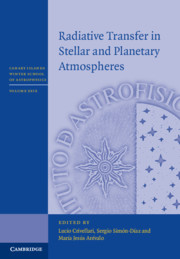Book contents
- Frontmatter
- Contents
- List of Contributors
- Preface
- Acknowledgements
- 1 The Physical Grounds of Radiative Transfer
- 2 Fundamental Physical Aspects of Radiative Transfer
- 3 Numerical Methods in Radiative Transfer
- 4 Stellar Atmosphere Codes
- 5 Radiative Transfer in the (Expanding) Atmospheres of Early-Type Stars, and Related Problems
- 6 Phenomenology and Physics of Late-Type Stars
- 7 Modelling the Atmospheres of Ultracool Dwarfs and Extrasolar Planets
7 - Modelling the Atmospheres of Ultracool Dwarfs and Extrasolar Planets
Published online by Cambridge University Press: 24 December 2019
- Frontmatter
- Contents
- List of Contributors
- Preface
- Acknowledgements
- 1 The Physical Grounds of Radiative Transfer
- 2 Fundamental Physical Aspects of Radiative Transfer
- 3 Numerical Methods in Radiative Transfer
- 4 Stellar Atmosphere Codes
- 5 Radiative Transfer in the (Expanding) Atmospheres of Early-Type Stars, and Related Problems
- 6 Phenomenology and Physics of Late-Type Stars
- 7 Modelling the Atmospheres of Ultracool Dwarfs and Extrasolar Planets
Summary
By absorbing and scattering both incident and emergent radiation, an atmosphere regulates a planet's thermal, chemical and cloud structure, and cooling through time. The photons transmitted through or scattered by an atmosphere provide one of our primary sources of information about planetary composition. Therefore, any effort to fully characterize an extrasolar planet must incorporate atmospheric models that attempt to fully describe the relevant processes and thereby predict a planet's reflected and emitted spectra. Brown dwarfs, ultracool substellar objects with atmospheric composition similar to those of many gas giant planets, provide a tractable training ground to test our ideas and models about atmospheric processes under conditions more exotic than found in the Solar System. This chapter aims to concisely summarize the various ingredients that must be included in any model and the overall process of atmospheric model creation for ultracool dwarfs and extrasolar planets. These considerations include the basic atmospheric structure equations, radiative transfer, atmospheric chemistry, clouds and various disequilibrium processes. Each of these topics is worthy of in-depth treatments, and pointers to appropriate review articles are provided for those wishing to understand each component in more detail.
- Type
- Chapter
- Information
- Radiative Transfer in Stellar and Planetary Atmospheres , pp. 223 - 238Publisher: Cambridge University PressPrint publication year: 2020

